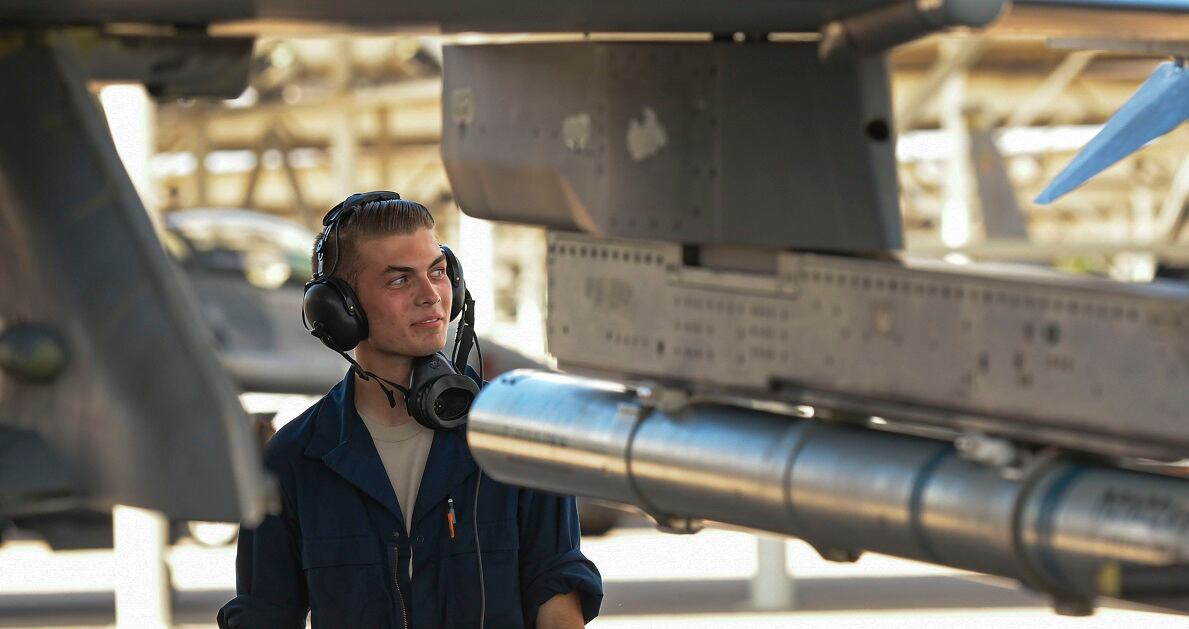HILL AIR FORCE BASE, Utah—Call it the “Island of Misfit Toys.”
Tucked away in a beige, concrete workshop at the 388th Maintenance Squadron here, the remnants of trashed F-35 Lightning II fighter jets are getting a second wind.
Airmen are turning unflyable aircraft into training assets for F-35 maintainers who would otherwise have to learn those lessons on an operational jet or a computer. The master sergeant in charge argues it’s saving the Air Force millions of dollars — and it’s fun, too.
Salvaging planes has become a pet project for Master Sgt. Andrew Wilkow, a maintainer with the 372nd Training Squadron. Rehabbing the wrecks is one of his full-time jobs, after a career of repairing battle damage and overhauling jets at maintenance depots.
Right now, he’s working on the beaten-up cockpit of a Marine Corps F-35B that crashed near Marine Corps Air Station Beaufort, South Carolina, in 2018. A Pratt & Whitney F135 engine that was salvaged from a 2020 mishap at Eglin AFB, Florida, sits nearby.
The idea started in 2020, when Wilkow helped the F-35 Joint Program Office reattach a jet’s wings — a process for which the program had no blueprint. That aircraft caught fire upon takeoff at Eglin in 2014.
Hill figured out a way to stick the wings back on, and later used the fuselage to train F-35 crew chiefs and maintainers in repairing combat damage. Then an acquaintance at the program office wanted to repay the favor.
“[He] said, ‘Hey, I’ve got some crashed jet parts. Do you want those?’” Wilkow said. “That turned into … ‘Well, what can’t I have?’”
RELATED
Wilkow has taken in carcasses from three other F-35s since then.
After an F-35A from Luke AFB, Arizona, caught fire in 2016, Wilkow had it sawed in half so maintainers could tinker with the inside of a real jet. The F135 engine from the 2020 Eglin mishap, and the 25 mm GAU-22/A four-barrel Gatling gun from the same plane, will be static displays where airmen can learn how to inspect the hardware.
Teaching airmen to use a borescope, a tool that lets mechanics look through tiny holes, is particularly important for catching internal troubles that could cause an engine to malfunction.
The Marine Corps cockpit should be ready in November to teach people about landing gears, avionics and more, Wilkow said. That process involves steps like removing contaminants, softening sharp edges, fabricating new panels and other broken components, and attaching a new canopy.
He plans to install a computer into the cockpit so airmen can see the same training cues as they would get at a desk, without sending the jet back to a private company. Dumpster diving turns up other parts that can come in handy for free.
“These airplanes cost so much money [that] with a mishap, it’s a loss,” he said. “But for maintenance, it doesn’t have to be. … We can turn something that was garbage into something that you never had.”
Maintainers typically learn about their aircraft using operational jets, which means units have to choose between keeping planes on the ground or delaying their own training.
And plenty is off-limits for those planes: You can’t “lift an operational jet with a crane, collapse the front landing gear and then set the nose of the aircraft on the ground without significant risk of damaging it,” Wilkow said in a release last year.
RELATED

Those involved in refurbishing the F-35s hope they’ll become a key part of new coursework to train airmen faster, particularly as the Air Force looks to merge some maintenance specialties and rebuild that workforce.
An exodus of more experienced mechanics led to thousands of vacant repair jobs, which the Air Force has fought to refill. Now, Wilkow hopes his salvaged planes can help get younger technicians up to speed.
“The [Ogden Air Logistics Complex] depot itself is having a hard time with keeping their people — Northrop Grumman down the street is paying more,” he said. “With new people coming in, not having a lot of experience … this is to help everyone.”
The salvaged planes can build trainees’ confidence and make them more comfortable at work, said Tech. Sgt. Kevin Browning, who works on the jet’s stealth features with the 388th Maintenance Squadron.
“With the new generation of airmen, most of them haven’t even touched tools before,” he said. “We have to charge them with drilling holes in a $120 million airplane. You want to make the mistake here, and learn here, before you go out and exercise that ability.”
They also serve to educate civilian employees and contractors who may only have experience repairing fourth-generation aircraft. More advanced aircraft like the F-35, F-22 Raptor and B-2 Spirit require a more precise hand than their earlier counterparts, Browning said.
“[On] B-52s, if it’s not coming off, you hit it harder,” he said. “You don’t do that on an F-35. Everything’s pieced together perfectly.”

Wilkow said the project can save the Air Force tens of millions of dollars on buying new training systems from F-35 manufacturer Lockheed Martin.
Progress can be slow, in part because the people and equipment needed to get the job done are in short supply. But Wilkow said it’s worth it.
“When the Air Force spends so much money on the aircraft, maintenance doesn’t get the fancy simulators to train on,” he said. “It’s a neat opportunity for us to get nice, new toys — even if they’re garbage.”
His advice to other airmen who want to do the same: Build a good plan, communicate it well and follow through.
“This takes a lot of creativity and innovation, thinking outside the box,” he said. “If you have something good, stick with it.”
Rachel Cohen is the editor of Air Force Times. She joined the publication as its senior reporter in March 2021. Her work has appeared in the Washington Post, the Frederick News-Post (Md.), Air and Space Forces Magazine, Inside Defense, Inside Health Policy and elsewhere.




